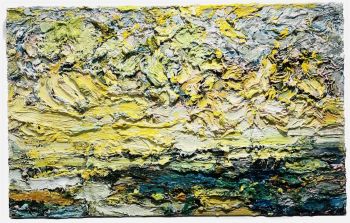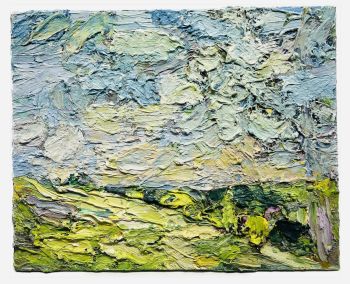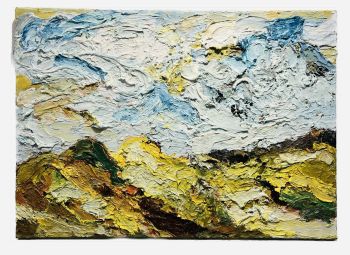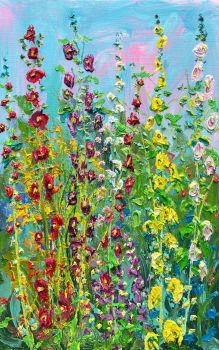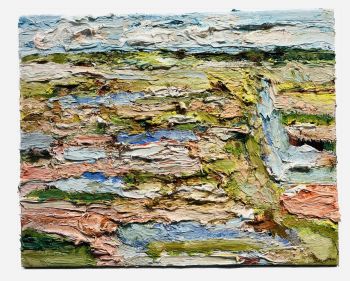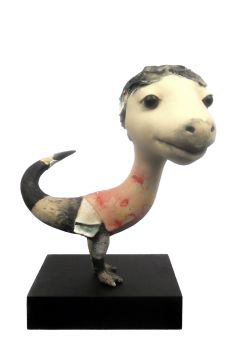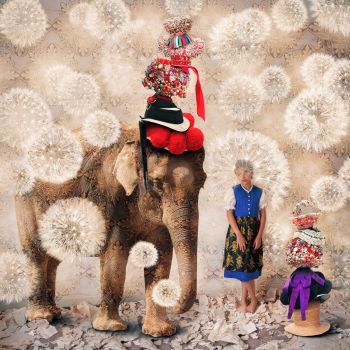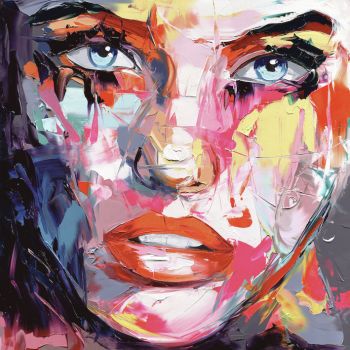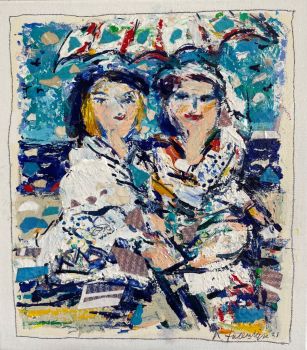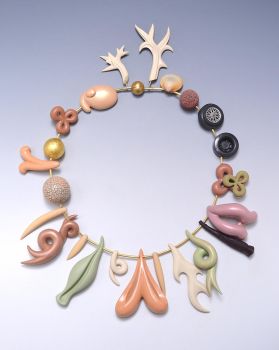All about expressionism in painting
Painting has many different art 'movements and styles', with 'expressionism' being a frequently heard term. But what exactly means expressionism and when is an artwork 'expressionistic'. How did this art movement originate and what are the main characteristics? In this article we try to clarify this further with examples and images. We also indicate in this article where you can view expressionistic works of art, which are offered and can be bought at renowned galleries.
Where does the word expressionism come from?
The word "expressionism" comes from the Latin word"expressio" and literally means "expressing" feelings. It is a movement in European art and literature from the early twentieth century, between 1905 to 1940. In expressionism, the artist tries to express his or her feelings or experiences through a certain 'distortion' of reality. Expressionism is also called 'the art of expression'.
 Blue Mountain, 1908–09, Wassily Kandinsky in his early years with one of the first expressionist paintings
Blue Mountain, 1908–09, Wassily Kandinsky in his early years with one of the first expressionist paintings
What are the main principles of expressionism?
Expressionism as a style is best known in painting, but can also be found in music, literature, architecture, drama and in film. Expressionism focuses on the artist's personal, subconscious response to his environment.
In this way it opposed 'impressionism' (see also more in our other article about this), which presupposed precisely the representation of the 'sensory experience' reality. In expressionism this link with reality fades and sometimes even disappears completely. This gives previously unimaginable new shapes their chance. Expressionism knows no laws.
The two main principles are therefore: 'there are no laws' and 'laws should not be imposed by anyone.' More is painted from the feeling (the child) than from the ratio (intelligence). In short, within Expressionism the artist tries to shape his feelings, his experiences by distorting/simplifying reality.
In painting, the term 'expressionist' is now used for any painting that expresses an expressionist state of mind, even if it is not from the early twentieth century.
How do you recognize expressionism?
Expressionist painting deviates from reality mainly through the use of color. Different colors are used to accentuate feelings. Also, to enhance the expressive power, natural objects are distorted, and the perspective is sometimes intentionally released. Other academic (conventional) formal and visual language is also deliberately avoided, for example the application of the golden ratio as in classical art.
The basic characteristics of expressionism are ecstatic, bright and unnatural colours, erratic images, distortions, coarsely painted, flat surface, no perspective.
 Example of an impressionist painting by Wassily Kandinsky 'Street in Murnau with Women', 1908
Example of an impressionist painting by Wassily Kandinsky 'Street in Murnau with Women', 1908
Characteristic of expressionist art is the bright use of colour, the distortions and the capricious arrangement of a composition. Ignoring spatiality and deliberately ignoring laws of perspective is also frequently applied in expressionist art. Human figures are not represented plastically, but look 'flat', as if there are only two dimensions.
Where and when did expressionism start?
We can say that the foundation for expressionism was actually laid by the Western artists who called themselves the "primitives" at the end of the 19th century. This is the name for art in which primitive elements or forms are used. Characteristics of primitivist art include the lack of perspective and a more or less abstract representation of the subject. Early modern artists such as Cubists and Expressionists were strongly influenced by African and Oceanic art through collections of objects from the colonies. But otherwise artists with primitivist influences differ too much from each other to really speak of a style or movement.
Expressionism as a movement only really started to become a movement in Germany at the beginning of the twentieth century. The important first representatives of expressionism were the artist movements Die Brücke and Der Blaue Reiter.
At the same time, Fauvism, an art movement in painting comparable to German Expressionism, also emerged in France. Mention should be made of, among others, Paul Gauguin and Vincent Van Gogh . French Fauvism is closely related to German Expressionism.
In 1911 the art critic Herwarth Walden only officially introduced the term "expressionism" in his magazine "Der Sturm".
 Henri Matisse, Fauvist portrait of Mrs. Matisse / The green line, 1905
Henri Matisse, Fauvist portrait of Mrs. Matisse / The green line, 1905
Die Brücke as the first important expressionist movement
In 1905, Die Brücke, which was founded in Dresden. Die Brücke was founded by architecture students Ernst Ludwig Kirchner, Erich Heckel, Karl Schmidt-Rottluff and Fritz Bleyl. 'Man and the landscape' were the main motifs depicted by this group of artists. Their main aim was to 'paint natural life as such' according to Erich Heckel. It was about 'expressing feelings of landscape or people in the simplest possible way.' Die Brücke's group became known partly for their robust woodcuts. The group did not last long, however. In 1908 most of the members moved to Berlin, where the group was disbanded in 1913.
 Ernst Ludwig Kirchner - Self Portrait of a Soldier 1915, typical example from 'Die Brucke', a well-known Expressionist movement in Germany
Ernst Ludwig Kirchner - Self Portrait of a Soldier 1915, typical example from 'Die Brucke', a well-known Expressionist movement in Germany
Der Blaue Reiter as the second important expressionist movement
Der Blaue Reiter was founded in 1911 by Wassily Kandinsky, Gabriele Münter, Franz Marc and Alfred Kubin. The group was named after an equestrian painting that Kandinsky had already painted in 1903. The aim of the group was idealistic, the members mainly wanted to maintain a bond of close friendship with each other. There was no program, there were no style rules.
 Beginning of Expressionism, Der Blaue Reiter van de painterWassily Kandinsky, 1903
Beginning of Expressionism, Der Blaue Reiter van de painterWassily Kandinsky, 1903
In 1911 and 1912 Kandinsky and Franz Marc organized a touring exhibition in Germany under the responsibility of the editors of Der Blaue Reiter. In 1912 they published an almanac on issues concerning modern art. In their exhibitions they offered space to everything and everyone whose work they considered important. For example, it also happened that Pablo Picasso and Hans Arp were participants in some of their exhibitions. The group failed to achieve its idealized goal and soon disintegrated after the outbreak of World War I.
Characteristic for Der Blaue Reiter was mainly the abstract, no clear representation. Where nature is a popular theme and the use of secondary and primary colors, geometric design.
 Franz Marc: Die gelbe Kuh, 1911, example of bright primary colors and of the early expressionist movement called 'De Blaue Reiter'
Franz Marc: Die gelbe Kuh, 1911, example of bright primary colors and of the early expressionist movement called 'De Blaue Reiter'
Influence of Nietzsche on expressionism
In his book "Die Geburt der Tragödie" Nietzsche developed the theory of an absolute discord in the aesthetic experience, distinguishing between a 'a world of the mind', order and regularity and a world of 'intoxication and chaos'. The 'Apollinian' represented for Nietzsche the "rationally conceived" ideal, while for him the "Dionysian" stood for the "actual artistic conception", arising from the human subconscious. With this parallel from the Greek world of the gods, Nietzsche wanted to indicate the relationship between these two extremes: two sons of the gods, who are simultaneously incompatible and inseparable. According to Nietzsche, both elements are represented to a greater or lesser extent in every work of art.
 Portrait of Friedrich Nietzsche painted by Edvard Munch in 1906, this well-known expressionist painter was best known for his famous painting "The Scream"
Portrait of Friedrich Nietzsche painted by Edvard Munch in 1906, this well-known expressionist painter was best known for his famous painting "The Scream"
The emergence of Dutch expressionist movements
In the Netherlands, a group of artists formed in Groningen in 1918, De Ploeg, who embraced expressionism. De Ploeg stood for innovation, "ploughing". The well-known painter Jan Altink is the creator of the name. In addition to Jan Altink, the art circle consisted of, among others, Jannes de Vries, Jan Jordens, Johan Dijkstra, Hendrik Werkman, Anton Buytendijk and Jan Wiegers. Jan Wiegers is the one who met and worked with Ludwig Kirchner in Davos Ernst, on his return to the Netherlands he introduced Kirchner's style to his fellow Team members. The Groninger Museum and Stedelijk Museum nowadays have an extensive collection of De Ploeg.
 Painting by Jan Altink, The Red Farm, 1924 as an example of the Dutch Expressionist Movement 'De Ploeg'
Painting by Jan Altink, The Red Farm, 1924 as an example of the Dutch Expressionist Movement 'De Ploeg'
The 'modern' neo-expressionist
However, expressionist works were also painted in earlier and later periods. Expressionism as an expression style still exists at the beginning of the 21st century. Also in the period well before the heyday, painters can be found who, incidentally, used an expressionist style.
In 1948 a number of Surrealists, Fauvist and Expressionists united in the Cobra group, as they had related art views. This movement, which elaborates on expressionism, is responsible for the revival of modern art, especially in the Netherlands, but also in Belgium and Denmark.
Cobra artists include: Karel Appel, Corneille, Jan Nieuwenhuijs, Theo Wolvecamp, Christian Dotremont, Pierre Alechinski, Carl-Henning Pedersen, Asger Jorn, Constant Nieuwenhuijs, Anton Rooskens, Henry Heerup, Gerjan Heijkoop.
 Corneille as well-known Dutch expressionist painter
Corneille as well-known Dutch expressionist painter
Where can you buy expressionist paintings these days?
Here at Gallerease you can find an overview of original and modern expressionist works that are for sale and from the best galleries.
 Example of expressionist work 'Le Coquelicot' 1960, by Kees van Dongen available via Gallerease
Example of expressionist work 'Le Coquelicot' 1960, by Kees van Dongen available via Gallerease
*The image in the header is a detail of the oil painting made by Ernst Ludwig Kirchner, Czardas dansers, 1908







